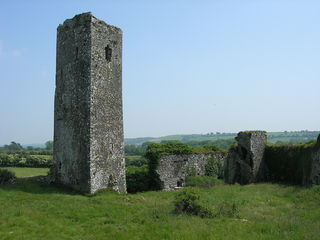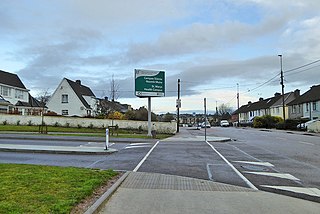
Glengarriff is a village of approximately 140 people on the N71 national secondary road in the Beara Peninsula of County Cork, Ireland. Known internationally as a tourism venue, it has a number of natural attractions. It sits at the northern head of Glengarriff Bay, a smaller enclave of Bantry Bay.

Ballymun is an outer suburb of Dublin, Ireland, at the northern edge of the Northside, the green-field development of which began in the 1960s to accommodate a housing crisis in inner city areas of Dublin. While the newly built housing was state-of-the-art at the time, comprising high-rise tower blocks and flat complexes, residents were moved in years before shops, schools and other infrastructure were fully ready, and the area became well known for both a strong community spirit and considerable social challenges. Ballymun has several sub-districts such as Sillogue, Coultry, Shangan and Poppintree, and is close to both the Republic of Ireland's only IKEA store and to Dublin Airport. The area is the source of one Dublin river, and parts lie in the floodplain of another, and there are a number of parks.

Páirc Uí Chaoimh is a Gaelic games stadium in Cork, Ireland. It is the home of Cork GAA. The venue, often referred to simply as The Park, is located in Ballintemple and is built near to the site of the original Cork Athletic Grounds. The stadium opened in 1976 and underwent a significant two-year redevelopment before reopening in 2017.

Castlemilk is a district of Glasgow, Scotland. It lies to the far south of the city centre, adjacent to the Croftfoot and Simshill residential areas within the city to the north-west, the town of Rutherglen - neighbourhoods of Spittal to the north-east and Fernhill to the east, Linn Park and its golf course to the west, and the separate village of Carmunnock further south across countryside.

Ballincollig is a suburban town within the administrative area of Cork city in Ireland. It is located on the western side of Cork city, beside the River Lee on the R608 regional road. In 2016 it was the largest town in County Cork, at which time the Ballincollig Electoral Division had a population of 18,621 people. It is located beyond the green belt from the suburbs of Bishopstown and Wilton. Historically home to the Ballincollig Royal Gunpowder Mills which is now a Regional Park, the town has seen much growth in recent years as a satellite of Cork City. Ballincollig is within the Cork North-West Dáil constituency.
Palmerstown is a civil parish and suburb in western Dublin on the banks of the River Liffey. It forms part of the South Dublin local authority and the Dublin Mid-West parliamentary constituency. The area is bordered to the north by the River Liffey, to the west by Lucan, to the south-west by Clondalkin, to the south by Ballyfermot and to the east by the village of Chapelizod. Palmerstown village is situated near the Liffey Valley Shopping Centre. The area is situated near the major junction of the M50 motorway and the N4. It lies approximately 7 km west of O'Connell Street in Dublin city centre. The Old Lucan Road, once the main route from the city to the west, passes through the centre of Palmerstown village.

The Falls Road is the main road through West Belfast, Northern Ireland, running from Divis Street in Belfast City Centre to Andersonstown in the suburbs. The name has been synonymous for at least a century and a half with the Catholic community in the city. The road is usually referred to as the Falls Road, rather than as Falls Road. It is known in Irish as the Bóthar na bhFál and as the Faas Raa in Ulster-Scots.

Phibsborough, also spelled Phibsboro, is a mixed commercial and residential neighbourhood on the Northside of Dublin, Ireland.

Blackpool is a suburb of Cork city in County Cork, Ireland. It is situated in the north of the city, on the N20 road to Mallow. Blackpool is part of the Cork North Central Dáil constituency.

Oatlands is an area in the city of Glasgow, Scotland. It is situated south of the River Clyde, falls within the Southside Central ward under Glasgow City Council, and is part of the Gorbals historic area. Its boundaries are Hutchesontown and the Southern Necropolis cemetery to the west, Polmadie to the south, Shawfield to the east, and Glasgow Green public park to the north.
Mahon is an area to the south-eastern side of Cork, Ireland. Mahon gets its name from Lough Mahon, a wide stretch of the upper section of Cork Harbour. It was once a semi-rural peninsula, but from the late 20th century was subject to residential development, and has a number of housing estates and developments. The area was generally known as the Ring of Mahon, and is the site of Ringmahon House. Mahon is within the Cork South-Central Dáil constituency.

Douglas is a suburb, with a village core, in Cork city, Ireland. Douglas is also the name of the townland, Roman Catholic parish, Church of Ireland parish and civil parish in which it is contained.

Passage West is a port town in County Cork, Ireland, situated on the west bank of Cork Harbour, some 10 km south-east of Cork city. The town has many services, amenities and social outlets. Passage West was designated a conservation area in the 2003 Cork County Development Plan.

Knocknaheeny is an electoral division and suburb in Cork city, located north of the River Lee on hills overlooking the city. It is a mainly residential area, and contains a number of terraced council housing estates. Apple's headquarters for Europe, the Middle East and Africa is located in the area, and employs about 3,000 people.

Armoy is a village and civil parish in County Antrim, Northern Ireland. It is 5.5 miles (9 km) southwest of Ballycastle and 8 miles (13 km) northeast of Ballymoney. According to an estimate in 2013 by the Northern Ireland Statistics and Research Agency it had a population of 1,122.

Cork is the second largest city in Ireland and third largest in the island of Ireland located in the south-west of Ireland, in the province of Munster. Following an extension to the city's boundary in 2019, its population is c. 210,000.

Glenbeigh or Glanbehy is a town and civil parish on the Iveragh peninsula in County Kerry, Ireland. The parish includes Rossbeigh beach, Coomasahran Lake and a number of important rock art sites. Owing to its natural heritage, history and its location on both the Ring of Kerry and Wild Atlantic Way, Glenbeigh is a tourist destination.

Gurranabraher is a residential suburb on the north western side of Cork City. Its bounds range from the North Cathedral to Bakers Road to Blarney Street. Gurranabraher is located in Cork North-Central Dáil Éireann constituency.
Tramore Valley Park is a park on the southside of Cork in Ireland. With an area of approximately 160 acres (65 ha), the park site is located on a landfill site which closed in 2009. While parts of the park opened in mid-2015, and had been targeted to open more completely during 2016, as of October 2018 the park had not been opened to the public on a broader scale or to larger events. The park was ultimately opened in May 2019, and is managed by the Glen Resource Centre on behalf of Cork City Council.

Applewood is a neighbourhood in the suburban town of Swords, near Dublin, Ireland. It was built around the year 2002 by property developer Gerry Gannon. It has been designed "village-style" with shops in the centre and housing estates surrounding this. In 2006, it won the Best Urban Village award at the National Tidy Towns competition.





















